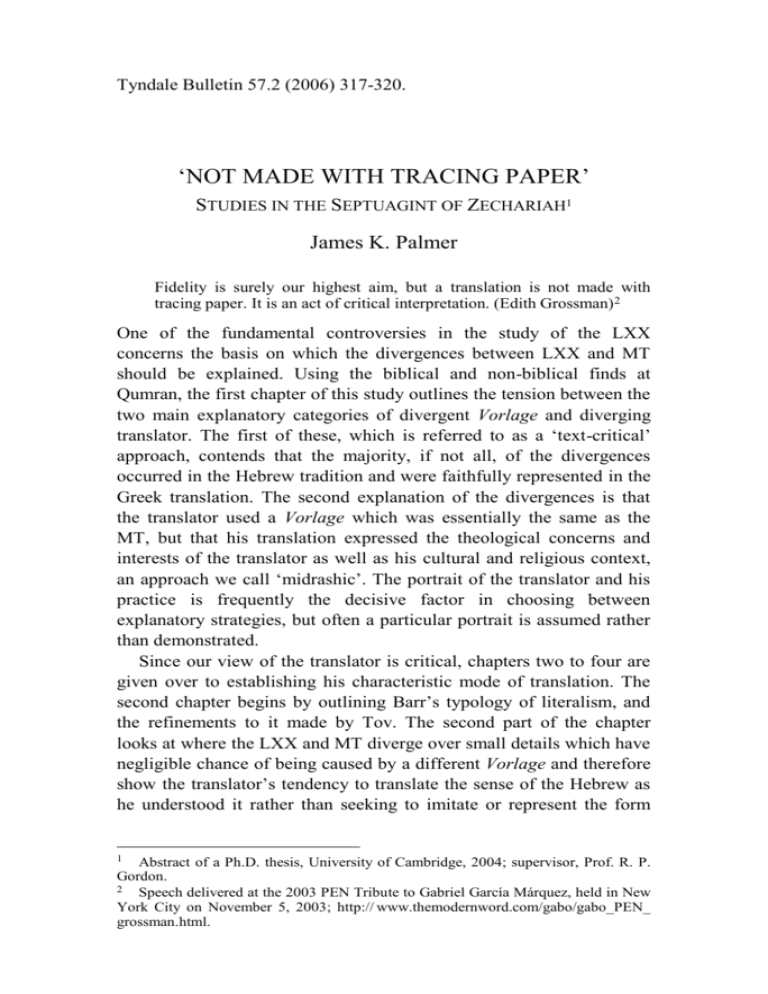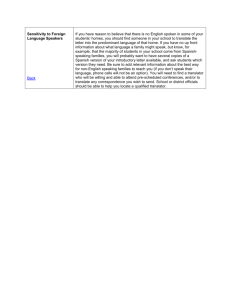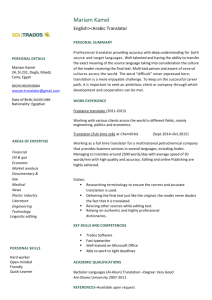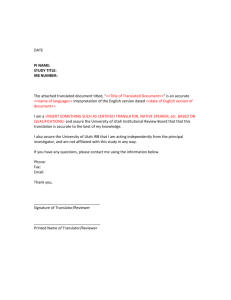Tyndale email addresses
advertisement

Tyndale Bulletin 57.2 (2006) 317-320. ‘NOT MADE WITH TRACING PAPER’ STUDIES IN THE SEPTUAGINT OF ZECHARIAH1 James K. Palmer Fidelity is surely our highest aim, but a translation is not made with tracing paper. It is an act of critical interpretation. (Edith Grossman) 2 One of the fundamental controversies in the study of the LXX concerns the basis on which the divergences between LXX and MT should be explained. Using the biblical and non-biblical finds at Qumran, the first chapter of this study outlines the tension between the two main explanatory categories of divergent Vorlage and diverging translator. The first of these, which is referred to as a ‘text-critical’ approach, contends that the majority, if not all, of the divergences occurred in the Hebrew tradition and were faithfully represented in the Greek translation. The second explanation of the divergences is that the translator used a Vorlage which was essentially the same as the MT, but that his translation expressed the theological concerns and interests of the translator as well as his cultural and religious context, an approach we call ‘midrashic’. The portrait of the translator and his practice is frequently the decisive factor in choosing between explanatory strategies, but often a particular portrait is assumed rather than demonstrated. Since our view of the translator is critical, chapters two to four are given over to establishing his characteristic mode of translation. The second chapter begins by outlining Barr’s typology of literalism, and the refinements to it made by Tov. The second part of the chapter looks at where the LXX and MT diverge over small details which have negligible chance of being caused by a different Vorlage and therefore show the translator’s tendency to translate the sense of the Hebrew as he understood it rather than seeking to imitate or represent the form 1 Abstract of a Ph.D. thesis, University of Cambridge, 2004; supervisor, Prof. R. P. Gordon. 2 Speech delivered at the 2003 PEN Tribute to Gabriel García Márquez, held in New York City on November 5, 2003; http:// www.themodernword.com/gabo/gabo_PEN_ grossman. html. 318 TYNDALE BULLETIN 57.2 (2006) and shape of the Vorlage. The third part of the chapter describes the stereotyping tendencies of the translation and the phenomenon of elegant variation, or variatio, is noted. Our brief survey notes that word-order is almost always literally rendered. Since there are different ways of being literal and free, a translation can be literal and free at the same time but in different ways. In the third chapter the translator’s strategies for translating words that he did not understand are analysed. This approach gives us a deeper insight into his priorities in translation. We consider six strategies suggested by Tov as the outline in this discussion: (1) untranslated words; (2) contextual guesses; (3) contextual ‘manipulation’ (‘misreading’ of graphically similar consonants to create words that fit better in the context); (4) reliance on parallelism; (5) employment of general words; and (6) etymological renderings. It is found that the translator’s ‘preferred’, though probably unconscious, method is contextual manipulation. Contextual guessing and etymological renderings were also favoured, whereas the employment of general and untranslated words was not. The large number of more ‘creative’ solutions to problematic words suggests that the translator was committed to decide on some rendering of the Hebrew, no matter how unsure he was, and it is highly unlikely that the evidence of the LXX should be taken as proof that unusual Hebrew words were exactly known by the translator. It is suggested that the approaches that a translator takes towards unknown words could be a useful factor in discussions of the unity of LXX-Minor Prophets. In the excursus to chapter three, it is asked whether the Septuagint translation of the Torah served as a lexicon in the translation of LXXZechariah, and we concluded that there is no strong evidence for this claim, and some evidence against it. A more general influence of the LXX-Torah is discussed. The process of reading an unvocalised text is considered in chapter four. It can be seen that, far from vocalisation preceding the perception of meaning, it is the perception of meaning that permits and facilitates the choice of vocalisation. This is true not only of vocalisation, but also of the related processes of reading homonyms and dividing words. The choices made are often indicative of the translator’s comprehension of the immediate context and larger intellectual background, as well as his purely linguistic understanding. PALMER: Septuagint of Zechariah 319 On the whole the translator is reliable and was evidently attempting to translate the sense of the text as he understood it, with respect for the Hebrew, but with no discernible desire to imitate its formal details apart from in the word order. For this reason there is a genuine possibility that the translation reflects, at least in some ways, the cultural, historical and theological context in which it was made. Chapters five to seven consider ways in which this might be the case. Chapter five looks at the projection of events which the MT considers to be past or present into the future, as well as at the greater emphasis on the centrality of Jerusalem. The future emphasis of LXXZechariah may be seen in the date of the LORD’s return to Jerusalem and the return of the exiles and the LORD’s dealings with them. The greater importance of Jerusalem in the LORD’s affection and plans is also considered. Since there are a number of examples which go against this tendency, it is concluded that the divergences are not necessarily part of a conscious agenda. They often occur when there is some ambiguity or difficulty in the Hebrew text and as such may suggest that the translator was doing no more than trying to understand what the text said. Chapter six examines four strands of thought that may be discerned in the divergences: the return of the exiles to Jerusalem; the joining of the nations to Israel to worship the LORD in Jerusalem; the exclusion of the Canaanites; and the expansion of Israel’s influence. The final chapter considers the extent to which the translator used euphemism in the translation of passages which relate to the doctrine of God. The translator apparently had scruples about saying that God could be seen by anyone indiscriminately. Likewise, the idea that God was pierced (12:10) was not translated, and there may be parallel issues with people hating God or attributing weakness to him (11:8), and with God’s mediatory figure being harmed (13:7). This shows how we can trace from within the LXX itself the beginning of the exegetical tradition which softened down anthropomorphisms and other ‘inappropriate’ expressions. This study suggests that the divergences between the LXX and the MT may be accounted for in several ways, often linguistic, sometimes textual; while in other cases they reflect the theological and cultural understanding, though not necessarily conscious Tendenz, of the translator. The translator was trying to the best of his ability and resources to translate the text in a responsible and coherent manner – 320 TYNDALE BULLETIN 57.2 (2006) though the ad hoc nature of LXX-Zechariah’s theological agenda suggests that the theology of LXX-Zechariah was not a definite system. The LXX rarely witnesses to a text other than that of the MT, and in only one or two cases may it represent a better text than the MT. More frequently than not, the divergences between MT and LXX are differences of understanding.








